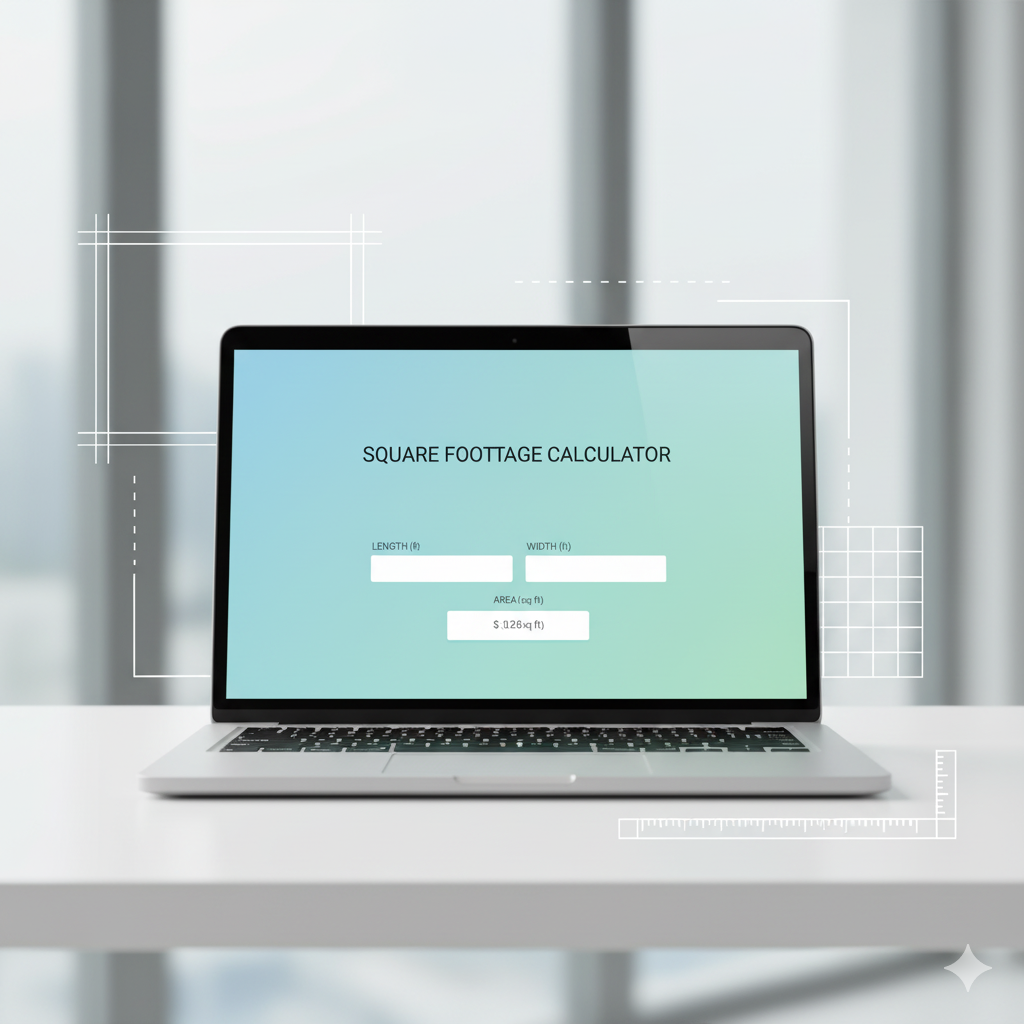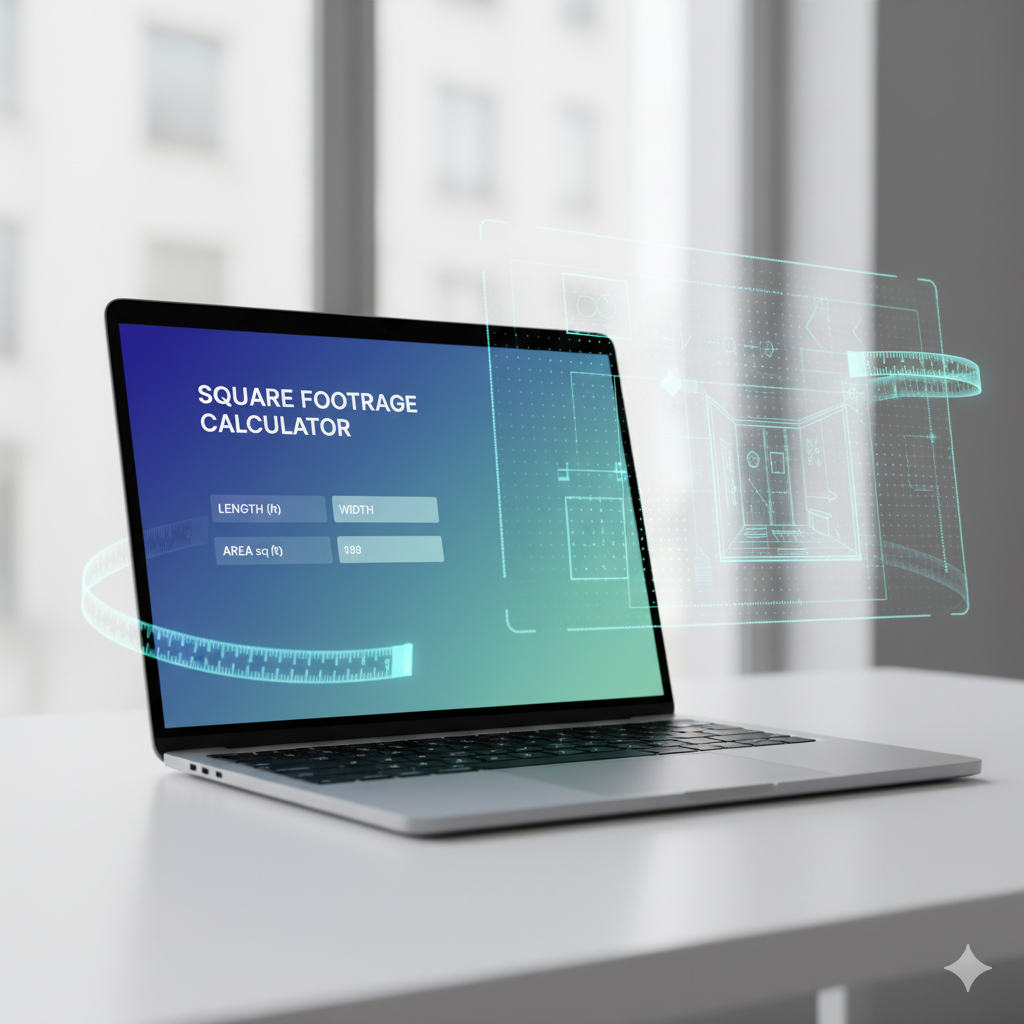Square Footage Calculator
Calculate the area of any room or space
This calculator provides approximate measurements. Always double-check critical calculations.
Introduction
Whenever you walk into a home, an office, or even a plot of land, one of the first questions that might pop into your head is: Just how big is this space? That's where Square Footage Calculator steps in. It's the go-to way to describe the size of any area, and figuring it out can really help you avoid headaches, save cash, and make things run smoother. Whether you're gearing up for a remodel, shopping for new floors, or checking out different properties, getting a handle on square footage—and maybe using a handy calculator—simplifies everything.
In this guide, we'll explore everything about square footage: what it really means, the smartest ways to figure it out, dealing with tricky shapes, the best tools to grab, and why getting it right is so important. By the time you're done reading, you'll feel confident measuring spaces and applying that info to everyday stuff like planning budgets, sprucing up your place, or sizing up real estate.
What is Square Footage Calculator?
Square footage is basically the total area of a space, measured in square feet. Picture laying down tiles that are each one foot by one foot across the floor—the total number of those tiles would give you the Square Footage Calculator.
This measurement pops up everywhere, from real estate ads and building projects to figuring out flooring, paint jobs, and beyond. For folks buying or renting, it tells you how much room you're actually getting for your buck. For builders and homeowners, it's key for estimating what materials you'll need and how much it'll all cost.
Why Square Footage Calculator Matters
Getting square footage spot-on isn't just for showing off in a property description. It has real, everyday benefits in all sorts of situations:
Renovation projects: You'll know precisely how much flooring, paint, or wallpaper to pick up.
Budgeting: Costs for materials and work are usually figured per square foot.
Property comparisons: The price per square foot is a common yardstick for judging if something's a good deal.
Legal compliance: Things like permits, zoning rules, and taxes can hinge on square footage.
Interior design: Planning where furniture goes, laying carpet, or deciding on room uses all rely on the space you have.
If your Square Footage Calculator isn't accurate, you could end up spending too much on supplies or not realizing a property's true worth.
Units and Conversions
Before you start use the Square Footage Calculator, it's smart to get familiar with the units involved.
Feet and inches: In the imperial system, feet are the main unit. One square foot is the same as a 12-inch by 12-inch square.
Meters and centimeters: Over in the metric world, areas are done in square meters (m²).
Conversions: Roughly, 1 square meter equals about 10.7639 square feet. And an acre? That's 43,560 square feet.
If you're dealing with both metric and imperial measurements, stick to one system. Always switch everything over before you do the math.
Types of Square Footage
Square footage isn't one-size-fits-all. Depending on what you're doing, you might focus on different kinds:
Finished square footage: This only covers areas that are ready to live in—think heated, cooled, and fully done-up spaces.
Total square footage: This includes every bit of built area, like unfinished basements, garages, or porches.
Usable square footage: The space you can actually use, minus things like walls, stairs, or closets that take up room.
Figuring out which type you need keeps things clear when you're measuring or stacking up different spaces.
Convert All of Your Measurements to Feet
One common slip-up when calculating square footage is juggling different units. You might have length in feet and width in inches, or flip to meters without adjusting. That's why converting everything to feet first is a great idea before you find the area.
Take a wall that's 8 feet 6 inches: Change those inches to part of a foot. With 12 inches making one foot, 6 inches is 0.5 feet. So, it becomes 8.5 feet.
Staying in feet keeps the math simple and your final number reliable. If you need to, you can convert the total square footage to square meters or yards later on.
Calculate the Area as Square Footage
With your measurements all in feet, it's time to multiply to get the area. For a straightforward rectangular room:
Square Footage = Length × Width
For instance: A room 12.5 feet long and 10 feet wide comes to 12.5 × 10 = 125 square feet.
If the area isn't a neat rectangle, split it into smaller sections like triangles or circles, work out each one, and add them up.
This approach makes sure you account for every nook, like odd corners or built-in spots, in your overall square footage.
How to Square Footage Calculator Work Manually
The easiest way is just multiplying length by width. For a rectangular room:
Area = Length × Width
Example: A 12-foot by 10-foot room equals 120 square feet.
But spaces aren't always simple rectangles. Here's how to handle various situations:
Squares/rectangles: Length times width.
Triangles: (Base × Height) divided by 2.
Circles: π times the radius squared.
Trapezoids: (Base1 + Base2) divided by 2, times height.
For weird layouts, chop the space into smaller, regular shapes, calculate them individually, and total them.
Step-by-Step Process
Measure dimensions: Grab a tape measure or laser device. Turn inches into decimal feet if necessary (like 6 feet 6 inches becomes 6.5 feet).
Break down complex rooms: For L-shaped or funky designs, divide into rectangles or triangles.
Apply formulas: Pick the right area formula for each part.
Add up totals: Combine the areas from each section.
Convert units: If you're in meters, multiply by 10.7639 for square feet.
Add waste margin: When getting flooring or paint, tack on 5–15% more.
Using a Square Footage Calculator
Doing the math by hand is okay, but a square footage calculator can make things a lot quicker and less hassle.
These online helpers let you:
Enter length and width straight in.
Deal with shapes like circles, triangles, and trapezoids.
Switch between feet, meters, and yards.
Combine multiple rooms.
Figure out costs if you have the per-square-foot price.
A solid one even lets you factor in "waste" for material orders.
Real-World Examples
Bedroom: 14 feet × 12 feet = 168 square feet.
Kitchen with L-shape: Split into 10 × 8 (80 square feet) and 6 × 5 (30 square feet). Total = 110 square feet.
Circular garden: Radius of 10 feet. Area = π × 100 = 314.16 square feet.
Metric conversion: Room 4 meters × 3 meters = 12 square meters. Times 10.7639 = 129.17 square feet.
Advanced Scenarios
Irregular Shapes
For rooms with strange outlines, draw a quick sketch of the floor and break it into easier parts. A calculator that works with polygons or curves can make it way simpler.
Multiple Floors
Figure out each level on its own, then sum them. For basements, think about if your needs include them or not.
Curved Walls
Estimate with parts of circles or go for a digital tool that follows curves.
Outdoor Areas
Things like patios, yards, and driveways use the same ideas. A trapezoid-shaped lawn, for example, might be easier with a calculator for odd shapes.
Mistakes to Avoid
Mixing units (feet with meters).
Rounding dimensions too early.
Forgetting alcoves, closets, or irregular extensions.
Ignoring unusable spaces like stairwells.
Not including waste when buying materials.
These slip-ups can cause major issues with costs and plans.
Square Footage in Real Estate
In buying or selling homes, square footage is a big deal. Listings often use "price per square foot." But differences happen because measuring methods vary.
Some include garages and raw basements.
Others stick to finished, habitable spots.
Always double-check the definition of square footage before comparing places.
For sellers, precise numbers build confidence. For buyers, it stops you from paying too much.
Square Footage for Renovations & Design
When you're updating floors, adding carpet, or painting, square footage tells you exactly what you'll need. For example:
Paint: A gallon typically covers around 350–400 square feet.
Carpet: Sold by the square foot or yard (1 square yard = 9 square feet).
Tile: Packages show square footage coverage.
A tiny mistake could mean running out of stuff—or having pricey leftovers.
Tools for Precision
Measuring tape: Classic and dependable.
Laser distance meter: Quick, exact, and ideal for bigger areas.
Apps: Lots of phone apps scan rooms to calculate square footage.
Blueprints: Design plans usually have spot-on measurements.
Mix hands-on tools with a calculator for top-notch results.
Square Footage Calculator Features to Look For
When choosing an online tool, watch for:
Handling of various shapes.
Options to convert units.
Ways to add multiple rooms or floors.
Built-in cost estimators.
A straightforward, user-friendly setup.
FAQs Square Footage Calculator
What is a square footage calculator?
It's an online helper that figures out area based on room sizes you enter. It often deals with different shapes and units.
Can I use a square footage calculator for irregular rooms?
Absolutely. Many let you split the space or enter detailed layouts.
Are these calculators accurate?
Yes, as long as your inputs are right. Mistakes mostly come from bad measurements.
Calculate Square Footage
How do you calculate square footage of a rectangular room?
Just multiply length by width in feet.
What about metric units?
Change meters to feet first, or calculate in square meters and convert after.
Do closets and hallways count?
Yes, if you're tallying total livable square footage.
Calculating Square Footage
Conclusion
Grasping and calculating square footage is crucial if you're a homeowner, renter, builder, or in real estate. A square footage calculator cuts down on time and slip-ups, but even doing it by hand is straightforward with the right formulas. By mastering proper measuring, handling complex shapes, and dealing with conversions, you'll dodge expensive errors and make better choices about space, supplies, and finances.
Square footage is more than a figure—it's the basis for planning, designing, and valuing properties. Learn it well, and it'll serve you in endless ways for years ahead.


